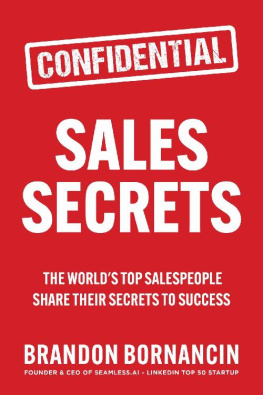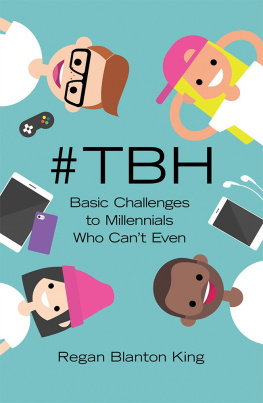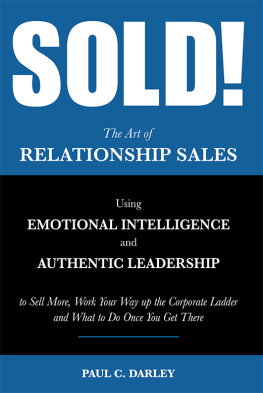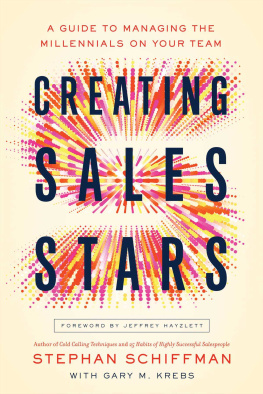OUTBOUND SALES, NO FLUFF
Learn the fundamentals of outbound selling to fill your funnel today.
Written by two millennials who have actually sold something this decade.
Outbound Sales, No Fluff
Table of Contents
Introduction
Ch 1 - Why does everybody hate salespeople?
Ch 2 - Stay in your lane!
Ch 3 - Target companies, sell to people
Ch 4 - Where is everybody?
Ch 5 - If cold calling is dead, I quit
Ch 6 - Bucket leads for maximum success
Ch 7 - Technology can save help you
Ch 8 - Funnel math
Appendix of Resources
Glossary of Terms
Stop & Take Action
About the Authors
Introduction
This book is a step-by-step guide for the modern sales professional to build a successful, repeatable outbound sales process.
Were giving you the framework, knowledge, and skills to fill your pipeline with highly qualified opportunities. Its all practical advice - no cutesy stories, no rants, and no product pitches.
Were writing for the individual sales rep, but the same concepts can also help sales leaders. Whenever we give leadership-specific advice, well put it in a box labeled ATTN: LEADERS. (Psst, sales reps! If youre smart, youll read these boxes in preparation for a future leadership role.)
Weve focused this book exclusively on outbound selling because thats the side of demand generation that lies within the individual sales reps control.
Sales is an industry full of jargon, so theres a glossary at the end of the book with terms you might not recognize. Weve also included an appendix of resources we think you should be aware of, including thought leaders to follow and tools to consider using.
Who are we to write a book about sales? After all, were just millennials.
Were two sales professionals who have learned from massive sales success as well as failure. Weve opened and closed millions of dollars in sales revenue in the last ten years. Most importantly, weve recognized, documented, and taught the patterns of success to hundreds of sales professionals across the globe.
By the last page youll have a powerful process for filling your sales pipeline with the kinds of companies and people who truly need what youre selling.
Thank You
Weve been fortunate to receive a great deal of support during the process of writing this book. If you have participated in any way, we thank you.
It would be impossible to mention everyone individually, but we will make special mention of four people who made significant contributions to the book, without whom we may never have gotten this far:
Molly Biberston
Lindsay Reisert
Kyle Porter
Cory Bray
Why does everybody hate salespeople?
Youve seen salespeople portrayed in movies and television - theyre usually awful. Think Glengarry Glen Ross , Wolf of Wall Street , or even Groundhog Day (remember the insurance salesman?).
Fortunately, you only need to know two things to become great at selling without becoming a caricature.
The first lesson of sales is...
Always be closing!
Coffees for closers!
Nope.
The first lesson is this: nobody cares about your product.
Well thats probably true for unknown brands. But were on the Inc 5000 - of course people care about our product!
Wrong. People care about themselves and their problems .
They dont want you to waste their precious time talking about features and functionality. They dont want to hear about how many awards your product has won. They want you to solve one of their problems.
So solve a problem or go away.
Consider this: if a million-dollar watch doesnt tell time any better than a ten-dollar watch, why is there a luxury watch market at all?
A ten-dollar watch solves the problem of needing to know what time it is.
A hundred-dollar watch solves the problem of needing to look stylish at the club.
A million-dollar watch solves the problem of needing to establish dominance in a business meeting.
Each watch solves a different problem , even though they all tell time.
In the end, our only job is to identify, engage, and close sales with buyers who are experiencing a problem our product will solve.
PRO TIP: Build a list of the problems your product solves. Use this list to qualify a prospect as early as possible. This will save you tons of time (and heartache).
If youre new to the product, ask the best sales rep at your company what problems they most commonly solve.
If youre a lone wolf, get permission to call a few of your companys best customers and ask what problem they were trying to solve when they bought.
ATTN: LEADERS If you leave it up to your sales reps to create a list of the problems your product solves, youre doing it wrong. Provide them with a list and regularly update it based on their conversations with qualified buyers. |
The second lesson of sales is...
If you want to be successful, start by helping others succeed.
Todays buyers have more information than ever before and rarely need a seller to guide them through the darkness. Plus, any product-based advantage you have now will be copied or improved upon in a matter of months by your competition.
So Ill be out of a job soon? I thought you were going to show me how to be successful.
If you define success as staying in the middle of the pack and contributing only enough to the world to stay employed, you can just skip ahead to the next chapter. Technology will soon replace you, so you dont have time to waste.
But if you define success as leading the pack and growing your career exponentially in the coming years, you need a different attitude.
Your future is about how many people you can help, not worrying about whats in it for you now.
Build a reputation of being that person - the one people can count on and utilize as a resource regardless of whether you close a sale with them. That kind of reputation can never be taken from you and will serve as an incredible career foundation.
STOP & Take Action
Look for the assignment marked Chapter 1 at the end of this book.
Stay in your lane!
The Pareto principle states that 80% of our output comes from 20% of our input. This means that the vast majority of the sales you close will come from very few of the companies you engage with. Our goal in this chapter is to help you identify the characteristics of the best companies to target so you waste as little time as possible working deals that wont close.
Its all about staying in your swimlane.
Figure A
Prospects who are too small |
----------Your swimlane---------- |
Prospects who are too big |
Prospects in the wrong industry |
Whats your swimlane? As shown in Figure A, its a set of criteria you can use to know whether or not a company is an ideal target to focus on. Dont worry, well help you figure out how this works.
WARNING
Most people think too broadly here. They want to include everyone who might benefit from their product. This is a bad idea and will lead to a lot of wasted effort because companies outside of your swimlane will still take a meeting. Theyll still watch a demo. But they will close at a much lower rate than your target buyers, which results in a ton of wasted effort.
For example, companies with at least $100MM in annual revenue is probably not a very accurate description of your target market. Your product probably doesnt provide the same degree of benefit to a $100MM mineral mining operation as it does to a $100MM hospital network.
Remember, only 20% of your sales effort is going to create 80% of your sales output. Dont try to be all things to all companies.
Next page







